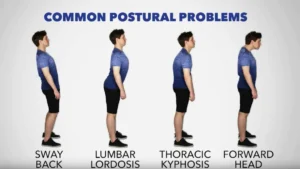Posture is defined as how your hold your body at all times. Regardless of the type of posture, the most important component of a good posture is that the spine is in a neutral and non-compromised position.
The most common symptoms of poor posture are the following:
- Neck Pain
- Headaches/Migraines
- Shoulder/Upper back pain
- Arm/hand numbness and tingling
- Jaw Pain (TMJ dysfunction)
- Back Pain
- Muscle fatigue/stress
- body aches and pain (Joint and muscle)
- Spinal degeneration and disc disease
Standing in the optimal posture is an art. However, if you master this art, the results can be very rewarding to your ultimate health goals.
READY TO FIX YOUR POSTURE???!!!!!!
STANDING POSTURE
- When standing: your head, shoulders, hips and ankles should line up, one comfortably above the other.
- You should bear your weight primarily on the balls of your feet.
- Do not lock your knees! Keep your knees slightly bent.
- Let your arms hang naturally down the sides of your body.
- Stand straight and tall with your shoulders pulled backward.
- Keep your head level-your earlobes should be in line with your shoulders. Do not push your head forward, backward, or to the side (aka DON’T do the “text neck”).
- Shift your weight from your toes to your heels, or one foot to the other, if you have to stand for a long time.
SITTING POSTURE
- Keep your feet on the floor or on a footrest, if they don’t reach the floor.
- Don’t cross your legs. Your ankles should be in front of your knees.
- Keep a small gap between the back of your knees and the front of your seat.
- Your knees should be at or below the level of your hips.
- Adjust the backrest of your chair to support your low- and mid-back or use a back support.
- Relax your shoulders and keep your forearms parallel to the ground.
- Avoid sitting in the same position for long periods of time.
- Your workstation ergonomics is also very important. Check the illustration on the right for the ideal set-up!




